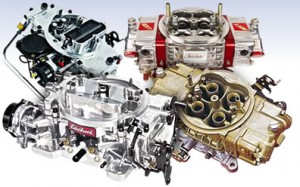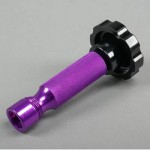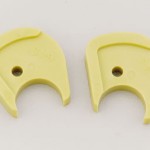 Ah, the carburetor.
Ah, the carburetor.
For some guys, it’s a symbol of American automotive performance…a genuine hot rodder’s answer to the “evils” of modern fuel injection. For others, it’s a source of great intimidation and frustration.
But it doesn’t have to be.
With help from the tech experts at Summit Racing, we’re sharing some typical cures to the new carb blues. Follow along, solve some typical carb conundrums, and get deputized as a Summit Racing carb detective!
Problem: Engine is running rich throughout the rpm band.
Solution #1: You may have the improper size (cfm) carburetor for your application. The carb’s cfm is directly related to your engine’s cubic inches and maximum rpm. Use this Carburetor Calculator to confirm the proper carburetor size for your application.
Solution #2: Although your carb’s floats are pre-adjusted from the factory, they often come out of adjustment during shipping. Check the float level and adjust to the manufacturer’s specifications. If the floats are too high, the carburetor will run rich.
Solution #3: If you’re running an aftermarket fuel pump, make sure the fuel pressure isn’t set too high. As rule of thumb, set your fuel pressure to these ranges based on the carburetor brand: 5-7 psi for Holley, Quick Fuel, AED, Willy’s, or Summit Racing; or 4-5 psi for Edelbrock or Jet.
Solution #4: If you have a carburetor with an electric choke, check and adjust the choke flap to make sure it is opening completely. If it is not opening all the way, there will be an airflow restriction that may cause your engine to run rich.
 Solution #5: Evaluate your air cleaner. Dirty air cleaners will restrict airflow and cause a rich condition. The same goes for small air cleaners—install a larger, less restrictive air cleaner if necessary.
Solution #5: Evaluate your air cleaner. Dirty air cleaners will restrict airflow and cause a rich condition. The same goes for small air cleaners—install a larger, less restrictive air cleaner if necessary.
Solution #6: If none of the above solutions fix the problems, you’ll need to check for other mechanical issues outside of the carburetor, including worn valve guides, improper spark plugs heat range, or bad valve seals.
Problem: Engine is running rich only at idle.
Solution #1: Try adjusting the mixture screws using a vacuum manifold vacuum gauge.
Solution #2: If you’re running a larger camshaft, engine vacuum will get very low and make the power valve open too early. Swap out the power valve to the correct one for the amount of engine vacuum being produced.
Problem: Engine is running lean.
Solution #1: Many times, the solutions for a rich condition can be reversed to cure a lean condition. Go back through the solutions listed above and take the opposite actions suggested for each solution.
Solution #2: Check for missing vacuum caps, examine the seal between the intake and carburetor, and look at the intake-to-head seal for leaks. A vacuum leak will make the engine run very lean and cause multiple drivability issues.
Problem: Engine stumbles under acceleration.
Solution #1: A low float level will create fuel starvation, which will cause the engine to stumble. Check the float level and make adjustments if necessary.
Solution #2: Check your fuel pressure and adjust it to these psi ranges: 5-7 psi for Holley, Quick Fuel, AED, Willy’s, or Summit Racing; or 4-5 psi for Edelbrock or Jet. Low pressure will cause fuel starvation during acceleration.
Solution #3: Again, if you’re running a larger camshaft, engine vacuum will get very low and make the power valve open too quickly. This often causes the engine to stumble, so you may need to change the power valve to match the engine vacuum levels in your application.
Solution #4: Depending on your engine combination, a stumble can be caused by a weak accelerator pump shot. Experiment with different accelerator pump cams and nozzle sizes.
Problem: Engine will not idle.
Solution #1: Check and adjust the idle screw. When you take the carburetor out of the box, this screw, which is located on the throttle shaft, is typically not turned in far enough to make the engine idle.
Solution #2: Poor idle quality can be caused by a vacuum leak. Check for missing vacuum caps or bad seals between the carb, intake, and cylinder heads.
Solution #3: Airflow restriction can also cause an engine to idle poorly. If you have a carburetor with an electric choke, make sure the choke flap is opening properly and adjust if necessary.
Solution #4: Examine the fuel filter. If the fuel filter looks old or beat up, dirt or other debris may have entered the carburetor and caused an obstruction. You’ll need to take the carb apart and look for contaminants.
Problem: Engine is backfiring through the carburetor.
Solution: The source of this problem is often something other than the carburetor itself. Typically, backfiring issues are caused by a timing issue, a worn cam lobe, or leaking valve. Check your timing and do a compression test to eliminate each of these possible problems.
If problems persist with your carburetor, here’s a one-size-fits-all solution: call the Summit Racing tech department at 1-330-630-0240. They’ll solve the problem, faster than you can say “case closed.”



What about when to much gas comes out from inside carb shaft?
Fuel leaking from the throttle shafts is typical when float level and/or fuel pressure is too high. Put a gauge in line and make sure fuel pressure does not exceed 4-6 psi for Edelbrock and 5-7 psi for a Holley/Demon or Summit Carbs.
Sumit Carb 750 Not flooding.and correct pressure with low float level but fuel leaks out of primary shaft when accelerator pump is used. its on A Pantera could is be the 5 deg angle of carb? any other ideas?
found the problem ,zero initial advance creating very low vacuum, all has come together after correcting this.
It seems like octane boosters can turn dual platinum spark plugs ugly colors. The missing cylinders can’t recover power. Is Summit Racing tech using 1 coil per cylinder and if so will each of the coils sense the low voltage condition caused by the no good spark plug electrode? And, please, g-mail us back the brand name of the coil-per-cylinder manufacturer which will sense, and, correct the fouled plug voltage rise time?
This particular question will require more information regarding your application. We’d recommend you call the Summit tech line at 330-630-0240.
Well its an 83 Chevy 4×4 4speed with granny low…you barely touch the throttle n it jumps up to 3k rpms n when you drive it down road n you go to slow down or put it in nuetral it stays at 4k rpms n if u touch throttle it will go higher and just stay there…all the while it smokes during tho process and smokes a ton. What could be causing this?
You don’t say what engine or fuel system ?
Guessing 350 with a Quadrajet.
Check fuel pressure. Should be 3 to 5 psi. If running Qjet.
Float setting to high. Stuck or dirty needle and seat.
BAD GRAMMAR IS THE LIKELY CAUSE
[…] TIPS by OnAllCylinders A couple of OnAllCylinders articles that showed up on my FB feed today Carb Detective: Troubleshooting 6 Typical New Carb Problems – OnAllCylinders 9 Cooling System Myths and Mistakes (Plus Helpful Cooling System Tips) Along with a few others […]
very interesting and useful THANK YOU
[…] fuel consumption, rough idle, hard starting, and more. We covered some of these issues in our Carb Detective and Carb Checklist […]
I have 350 SBC, Edelbrock Performer, headers, stock cam, Summit 600cfm. Timing at 12 BTDC. After getting on the throttle pretty good, the moment I let off, there seems to be a very, very brief forward power surge as my foot lifts. What could cause this?
Thanks for your question. We’d recommend a call to the Summit tech line at 330-630-0240 to track down the source of the problem.
I put a Holly 4 bbl on my 76 Blazer 350 cu.in. engine. The Holley has the plastic caps on the idle mixture screws. Can I remove those caps, to set the idle mixture with my vacuum gauge. The engine seems to be running rich and is not idling smooth.
Chevy 350 (comp cams Thumper) Holley brawler 650 (mech sec) tring to set idle under load (sits at 800-900 RPM) but in park races up to 1400-1600 RPM. Or I adjust in park at 800-900 RPM then I put in drive and it dies. I cant win! What am I doing wrong? Vacuum in park (800-900 rpm)(no Load)10-11 psi. vacuum under load (again adjusting Idle to 800-900RPM) 5-6 PSI. Aeromotive fuel regulator AN8 from tank AN6 to both bowls. Regulator reads 3.5 PSI an does not seem to be adjustable higher or lower. Not sure if bad yet.
Rocky,
Chevy 454 (427) w/396 crank, Eddy Brawler 680. Sudden gas pedal input will bring about a hesitation. Have to let up on the pedal and let it catch up or may begin bucking. More gradual “mashing” of the gas pedal seems to be ok. I have tried double-checking float levels, accelerator pump adjustments, and jetting changes. All of which do not appear to affect the behavior. Is this a sign of lean condition? Any idea what the next steps might be?
Throttle stocks on primary.
Carb was installed about 2 years ago about 1500 miles on it ran with no problem. Over the weekend developed the problem . Checked carb not loose or did not shift check throttle cable not a issue . When you take your hand to move throttle to idle position it clicks like a internal problem .
Is there a warranty . Should I send it in for service ?
I got a 1984 f150 with a 351 and a 2 barrel motor craft I just put this carb on yesterday and it’s giving me all kinds of problems if I have all the vacuum hoses connected it idles at 2800 rpm and if I disconnect one at the bottom it drops down to 1000 and it blows a lot of black smoke and at low rpm it’s not very smooth it’s studders really bad how do I fix this
And for the idle I have the screw backed all the way out and it still won’t go down and when I go to start it when the motor is warm I have to hold it to the floor and when it starts it don’t want to run for a few seconds it wants to die unless I hold the throttle
I have a pro form 950 main body and base plate I purchased new pro form bowl center hung floats seats ajusters primarily pump a used set of quick fuel metering blocks .
Now I have gas coming out top squerters with no water throttle . Use a bg pump with 6 psi at carb with regulator .
What would I try next
I have a 1989 ford 351w that I can not get the back 2 butterfly valves to open up, I think that i have tryed everything. but there must be something i have missed. It runs great in my driveway but when I put it on the water it just wont get up and go.
Hi
Carb will not ideal down .the adjment screw is adjusted all in.still idles a little higher then I like. In gear it will go on it own.
I have a 71 Ranchero with a 429 and an780 Holley. Revs great but stumbles under load. The engine and all components are new,but it is an old car and has been along time since I did a project like this. Where should I check first?
Holley quick fuel 750 DP mechanical secondary’s At a stop acceleration engines performs good. When your at 3000 rpm around 80 mph if you hit it hard the engine won’t do anything. Sounds like it wants to die. ??
Please help, I’m stuck. I have a hot rod that I have been building with a 650 quick fuel carb on it. After building the engine due to wife’s health the car sit fo over 6 years without starting. ignorance on my part. When I finally got back on the car the pistons were froze in place on the car. After several days I managed to free up the pistons and got it to turn over freely. But the fuel was being dumped into the crankcase. mechanical fuel pump which was a Holly was at 8psi, that is too much for the engine, got another fuel pump that is now pumping 5 psi. But the fuel is still getting in cylinders flooding out the spark plugs. So just the other day I rebuilt the carb. All internal parts, even external all still looked brand new. Rebuilding the carb was a breeze with no issues, however the spark plugs are still gettin gas soaked. Can’t keep the car running long enough to tune the carb. I have already changed the oil while building the carb as gas was in the oil. I’m pretty sure that I’m getting gas in my oil again. That can get expensive. I’m at your mercy can you please help me?